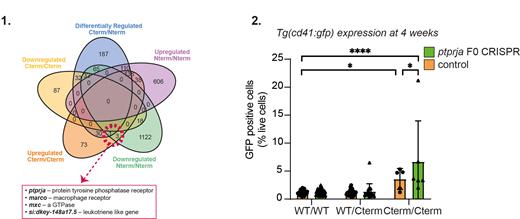10-20% of acute myeloid leukaemia (AML) cases in children and adults carry mutations in the transcription factor CCAAT/enhancer binding protein alpha (CEBPA). CEBPA is transcribed from a single exon and produces two isoforms, p30 and p42, with characteristic mutations, either frameshift mutations in the N-terminal portion ( CEBPA Nterm) leading to production of only the p30 isoform, or in frame mutations in the C-terminal portion ( CEBPA Cterm), disrupting DNA binding.
The most frequent secondary driver mutation in CEBPA-mutated AML, is the second allele of CEBPA. Additionally, in rare germline CEBPA cases, the founding mutation is usually CEBPA Nterm, with allindividuals showing acquisition of a second hit mutation in the CEBPA Cterm on the alternate CEBPA allele at the time of AML diagnosis, which has near 100% penetrance in these families. This highlights a strong selective pressure for this very specific biallelic mutation pattern.
We have developed zebrafish models with germline cebpa Nterm and cebpa Cterm mutations that faithfully recapitulates the disease, with all homozygous and double heterozygous mutants showing loss of mature myeloid cells, and impaired survival. All double or compound mutants die by 10 weeks of age, with haematopoietic stem and progenitor cell (HSPC) expansion, and leukaemia in around 30% of these animals.
Our model also demonstrates distinct phenotypes for cebpa Nterm and cebpa Cterm mutations during developmental haematopoiesis prior to leukaemia onset. We observed that cebpa Nterm and cebpa Cterm mutations have opposite effects on the expression of c-myb, a transcription factor expressed by proliferating HSPC, from 3 days post fertilization. cebpa Nterm/Nterm mutants show an increase in c-myb while cebpa Cterm/Cterm show reduced c-myb expression during development.
To uncover the mechanisms by which cebpa Nterm and cebpa Cterm effect HSPCs we undertook RNASeq of sorted Tg(cd41:eGFP) lo HSPCs from fish of all possible genotype combinations. We identified both shared and unique expression profiles between genotypes. We also identified 4 genes that that were differentially regulated in both cebpa Nterm/Nterm and cebpa Cterm/Cterm HSPC, but in opposing vectors (upregulated in cebpa Cterm/Cterm and downregulated in cebpa Nterm/Nterm) (Figure 1). We hypothesised that these 4 genes are candidate drivers of selective pressure for the common CEBPA Cterm/Ntermmutation combination in human AML, and thus the malignant phenotype it confers. One of these candidate genes, PTPRJ, has also recently been identified as a frequently mutated gene in CEBPA-mutated AML in children thereby validating the relevance of our dataset and our approach.
To define the effects of these 4 candidate genes we then conducted an F0 CRISPR knock-out screen in all cebpa mutant combinations in our zebrafish model, using c-myb expression as a phenotypic readout. We identified ptprja as our primary candidate gene and showed that loss of ptprja alone and in combination with cebpa Cterm/+ reduced expression of c-myb but had no effect on expression of c-myb in cebpa Cterm/Cterm, indicating that ptprja loss reduces c- myb-expressing HSPC and that this is dependent on functional cebpa DNA binding.
We then examined the impact of ptprja knockout in juvenile zebrafish. Homozygous and double heterozygous mutants develop a pre-leukaemia expansion of HSPC before they succumb to death. We showed that that loss of ptprja in cebpa Cterm/Cterm fish accelerates this pre-leukaemic expansion of Tg(cd41:eGFP) lo HSPCs in 4 week fish (Figure 2). We also showed an opposing effect in the cebpa Nterm/Nterm mutants at 2 weeks, where loss of ptprja resulted in decreased pre-leukemic expansion of HSPC.
These data indicate a role for PTPRJ in mediating HSPC expansion in CEBPA-mutated AML and suggest that PTPRJ may mediate the mechanism of clonal selection in those with a CEBPA mutation that drives the acquisition of a second CEBPA mutation on the opposing allele, leading to the common CEBPA Cterm/Nterm in patients with CEBPA-mutated AML.
Disclosures
Payne:Jazz: Honoraria; Novartis: Honoraria; clovis: Honoraria.


This feature is available to Subscribers Only
Sign In or Create an Account Close Modal